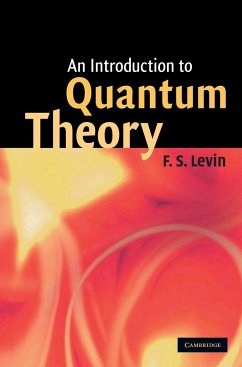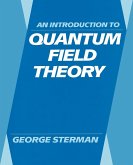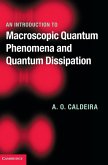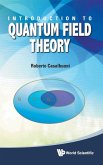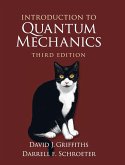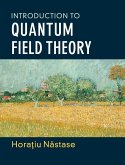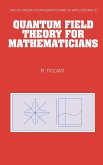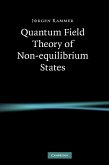- Gebundenes Buch
- Merkliste
- Auf die Merkliste
- Bewerten Bewerten
- Teilen
- Produkt teilen
- Produkterinnerung
- Produkterinnerung
An undergraduate introductory quantum mechanics textbook with a large number of figures and exercises.
Andere Kunden interessierten sich auch für
![An Introduction to Quantum Field Theory An Introduction to Quantum Field Theory]() George StermanAn Introduction to Quantum Field Theory141,99 €
George StermanAn Introduction to Quantum Field Theory141,99 €![An Introduction to Macroscopic Quantum Phenomena and Quantum Dissipation An Introduction to Macroscopic Quantum Phenomena and Quantum Dissipation]() A. O. CaldeiraAn Introduction to Macroscopic Quantum Phenomena and Quantum Dissipation73,99 €
A. O. CaldeiraAn Introduction to Macroscopic Quantum Phenomena and Quantum Dissipation73,99 €![INTRODUCTION TO QUANTUM FIELD THEORY INTRODUCTION TO QUANTUM FIELD THEORY]() Roberto CasalbuoniINTRODUCTION TO QUANTUM FIELD THEORY72,99 €
Roberto CasalbuoniINTRODUCTION TO QUANTUM FIELD THEORY72,99 €![Introduction to Quantum Mechanics Introduction to Quantum Mechanics]() David J. GriffithsIntroduction to Quantum Mechanics54,99 €
David J. GriffithsIntroduction to Quantum Mechanics54,99 €![Introduction to Quantum Field Theory Introduction to Quantum Field Theory]() Horatiu NastaseIntroduction to Quantum Field Theory81,99 €
Horatiu NastaseIntroduction to Quantum Field Theory81,99 €![Quantum Field Theory for Mathematicians Quantum Field Theory for Mathematicians]() Robin TicciatiQuantum Field Theory for Mathematicians207,99 €
Robin TicciatiQuantum Field Theory for Mathematicians207,99 €![Quantum Field Theory of Non-equilibrium States Quantum Field Theory of Non-equilibrium States]() Jørgen RammerQuantum Field Theory of Non-equilibrium States117,99 €
Jørgen RammerQuantum Field Theory of Non-equilibrium States117,99 €-
-
-
An undergraduate introductory quantum mechanics textbook with a large number of figures and exercises.
Produktdetails
- Produktdetails
- Verlag: Cambridge University Press
- Seitenzahl: 808
- Erscheinungstermin: 22. September 2014
- Englisch
- Abmessung: 250mm x 175mm x 47mm
- Gewicht: 1547g
- ISBN-13: 9780521591614
- ISBN-10: 0521591619
- Artikelnr.: 25498341
- Herstellerkennzeichnung
- Libri GmbH
- Europaallee 1
- 36244 Bad Hersfeld
- gpsr@libri.de
- Verlag: Cambridge University Press
- Seitenzahl: 808
- Erscheinungstermin: 22. September 2014
- Englisch
- Abmessung: 250mm x 175mm x 47mm
- Gewicht: 1547g
- ISBN-13: 9780521591614
- ISBN-10: 0521591619
- Artikelnr.: 25498341
- Herstellerkennzeichnung
- Libri GmbH
- Europaallee 1
- 36244 Bad Hersfeld
- gpsr@libri.de
F. S. Levin received his undergraduate degree from The Johns Hopkins University and his Ph.D. from University of Maryland. Following post-doctoral positions at Rice University, Brookhaven National Laboratory, and the United Kingdom Atomic Energy Author-ity, he accepted an appointment in the Physics Department at Brown University, where he remained for 31 years until his retirement in 1998.
Preface
Part I. Introductory: 1. The need for a non-classical description of microscopic phenomena
2. Classical concepts and quantal inequivalencies
3. Introducing quantum mechanics: a comparison of the classical stretched string and the quantal box
4. Mathematical background
Part II. The Central Concepts: 5. The postulates of quantum mechanics
6. Applications of the postulates: bound states in one dimension
7. Applications of the postulates: continuum states in one dimension
8. Quantal/classical connections
9. Commuting operators, quantum numbers, symmetry properties
Part III. Systems with Few Degrees of Freedom: 10. Orbital angular momentum
11. Two-particle systems, potential-well bound state problems
12. Electromagnetic fields
13. Intrinsic spin, two-state systems
14. Generalized angular momentum and the coupling of angular momenta
15. Three-dimensional continuum states/scattering
Part IV. Complex Systems: 16. Time-dependent approximation methods
17. Time-independent approximation methods
18. Many degrees of freedom: atoms and molecules
Appendix A. Elements of probability theory
Appendix B. Fourier series and integrals
Appendix C. Solution of Legendre's equation
Appendix D. Fundamental and derived quantities, conversion factors
References.
Part I. Introductory: 1. The need for a non-classical description of microscopic phenomena
2. Classical concepts and quantal inequivalencies
3. Introducing quantum mechanics: a comparison of the classical stretched string and the quantal box
4. Mathematical background
Part II. The Central Concepts: 5. The postulates of quantum mechanics
6. Applications of the postulates: bound states in one dimension
7. Applications of the postulates: continuum states in one dimension
8. Quantal/classical connections
9. Commuting operators, quantum numbers, symmetry properties
Part III. Systems with Few Degrees of Freedom: 10. Orbital angular momentum
11. Two-particle systems, potential-well bound state problems
12. Electromagnetic fields
13. Intrinsic spin, two-state systems
14. Generalized angular momentum and the coupling of angular momenta
15. Three-dimensional continuum states/scattering
Part IV. Complex Systems: 16. Time-dependent approximation methods
17. Time-independent approximation methods
18. Many degrees of freedom: atoms and molecules
Appendix A. Elements of probability theory
Appendix B. Fourier series and integrals
Appendix C. Solution of Legendre's equation
Appendix D. Fundamental and derived quantities, conversion factors
References.
Preface
Part I. Introductory: 1. The need for a non-classical description of microscopic phenomena
2. Classical concepts and quantal inequivalencies
3. Introducing quantum mechanics: a comparison of the classical stretched string and the quantal box
4. Mathematical background
Part II. The Central Concepts: 5. The postulates of quantum mechanics
6. Applications of the postulates: bound states in one dimension
7. Applications of the postulates: continuum states in one dimension
8. Quantal/classical connections
9. Commuting operators, quantum numbers, symmetry properties
Part III. Systems with Few Degrees of Freedom: 10. Orbital angular momentum
11. Two-particle systems, potential-well bound state problems
12. Electromagnetic fields
13. Intrinsic spin, two-state systems
14. Generalized angular momentum and the coupling of angular momenta
15. Three-dimensional continuum states/scattering
Part IV. Complex Systems: 16. Time-dependent approximation methods
17. Time-independent approximation methods
18. Many degrees of freedom: atoms and molecules
Appendix A. Elements of probability theory
Appendix B. Fourier series and integrals
Appendix C. Solution of Legendre's equation
Appendix D. Fundamental and derived quantities, conversion factors
References.
Part I. Introductory: 1. The need for a non-classical description of microscopic phenomena
2. Classical concepts and quantal inequivalencies
3. Introducing quantum mechanics: a comparison of the classical stretched string and the quantal box
4. Mathematical background
Part II. The Central Concepts: 5. The postulates of quantum mechanics
6. Applications of the postulates: bound states in one dimension
7. Applications of the postulates: continuum states in one dimension
8. Quantal/classical connections
9. Commuting operators, quantum numbers, symmetry properties
Part III. Systems with Few Degrees of Freedom: 10. Orbital angular momentum
11. Two-particle systems, potential-well bound state problems
12. Electromagnetic fields
13. Intrinsic spin, two-state systems
14. Generalized angular momentum and the coupling of angular momenta
15. Three-dimensional continuum states/scattering
Part IV. Complex Systems: 16. Time-dependent approximation methods
17. Time-independent approximation methods
18. Many degrees of freedom: atoms and molecules
Appendix A. Elements of probability theory
Appendix B. Fourier series and integrals
Appendix C. Solution of Legendre's equation
Appendix D. Fundamental and derived quantities, conversion factors
References.

